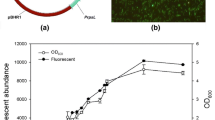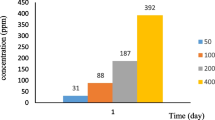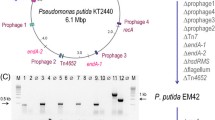Abstract
Agricultural soils are usually co-contaminated with organophosphate (OP) and pyrethroid pesticides. To develop a stable and marker-free Pseudomonas putida for co-expression of two pesticide-degrading enzymes, we constructed a suicide plasmid with expression cassettes containing a constitutive promoter J23119, an OP-degrading gene (mpd), a pyrethroid-hydrolyzing carboxylesterase gene (pytH) that utilizes the upp gene as a counter-selectable marker for upp-deficient P. putida. By introduction of suicide plasmid and two-step homologous recombination, both mpd and pytH genes were integrated into the chromosome of a robust soil bacterium P. putida KT2440 and no selection marker was left on chromosome. Functional expression of mpd and pytH in P. putida KT2440 was demonstrated by Western blot analysis and enzyme activity assays. Degradation experiments with liquid cultures showed that the mixed pesticides including methyl parathion, fenitrothion, chlorpyrifos, permethrin, fenpropathrin, and cypermethrin (0.2 mM each) were degraded completely within 48 h. The inoculation of engineered strain (106 cells/g) to soils treated with the above mixed pesticides resulted in a higher degradation rate than in noninoculated soils. All six pesticides could be degraded completely within 15 days in fumigated and nonfumigated soils with inoculation. Theses results highlight the potential of the engineered strain to be used for in situ bioremediation of soils co-contaminated with OP and pyrethroid pesticides.



Similar content being viewed by others
References
Cai L, Yuan MQ, Liu F, Jian J, Chen GQ (2009) Enhanced production of medium-chain-length polyhydroxyalkanoates (PHA) by PHA depolymerase knockout mutant of Pseudomonas putida KT2442. Bioresour Technol 100:2265–2270
Cho JH, Kim EK, So JS (1995) Improved transfomation of Pseudomonas putida KT2440 by electroporation. Biotechnol Tech 9:41–44
Cui ZL, Li SP, Fu GP (2001) Isolation of methyl parathion-degrading strain M6 and cloning of the methyl parathion hydrolase gene. Appl Environ Microbiol 67:4922–4925
Dong YJ, Bartlam M, Sun L, Zhou YF, Zhang ZP, Zhang CG, Rao Z, Zhang XE (2005) Crystal structure of methyl parathion hydrolase from Pseudomonas sp. WBC-3. J Mol Biol 353:655–663
Espinosa-Urgel M, Kolter R, Ramos JL (2002) Root colonization by Pseudomonas putida: love at first sight. Microbiology 148:341–343
Fabret C, Ehrlich SD, Noirot P (2002) A new mutation delivery system for genome-scale approaches in Bacillus subtilis. Mol Microbiol 46:25–36
Goh YJ, Azcárate-Peril MA, O’Flaherty S, Durmaz E, Valence F, Jardin J, Lortal S, Klaenhammer TR (2009) Development and application of a upp-based counterselective gene replacement system for the study of the S-layer protein SlpX of Lactobacillus acidophilus NCFM. Appl Environ Microbiol 75:3093–3105
Graf N, Altenbuchner J (2011) Development of a method for markerless gene deletion in Pseudomonas putida. Appl Environ Microbiol 77:5549–5552
Hannink N, Rosser SJ, French CE, Basran A, Murray JAH, Nicklin S, Bruce NC (2001) Phytodetoxification of TNT by transgenic plants expressing a bacterial nitroreductase. Nat Biotechnol 19:1168–1172
Hernándeza AF, Parrónb T, Tsatsakisd AM, Requenab M, Alarcónc R, López-Guarnidoa O (2013) Toxic effects of pesticide mixtures at a molecular level: their relevance to human Health. Toxicology 307:136–145
Iyer R, Iken B, Damania A (2013) A comparison of organophosphate degradation genes and bioremediation applications. Environ Microbiol Rep 5:787–798
Jackson CJ, Liu JW, Carr PD, Younus F, Coppin C, Meirelles T, Lethier M, Pandey G, Ollis DL, Russell RJ, Weik M, Oakeshott JG (2013) Structure and function of an insect α-carboxylesterase (αEsterase7) associated with insecticide resistance. Proc Natl Acad Sci USA 110:10177–10182
Jacques RJ, Okeke BC, Bento FM, Teixeira AS, Peralba MC, Camargo FA (2008) Microbial consortium bioaugmentation of a polycyclic aromatic hydrocarbons contaminated soil. Bioresour Technol 99:2637–2643
Jiang J, Zhang R, Li R, Gu JD, Li S (2007) Simultaneous biodegradation of methyl parathion and carbofuran by a genetically engineered microorganism constructed by mini-Tn5 transposon. Biodegradation 18:403–412
Keller KL, Bender KS, Wall JD (2009) Development of a markerless genetic exchange system for Desulfovibrio vulgaris Hildenborough and its use in generating a strain with increased transformation efficiency. Appl Environ Microbiol 75:7682–7691
Kristich CJ, Manias DA, Dunny GM (2005) Development of a method for markerless genetic exchange in Enterococcus faecalis and its use in construction of a srtA mutant. Appl Environ Microbiol 71:5837–5849
Lal R, Pandey G, Sharma P, Kumari K, Malhotra S, Pandey R, Raina V, Kohler HP, Holliger C, Jackson C, Oakeshott JG (2010) Biochemistry of microbial degradation of hexachlorocyclohexane and prospects for bioremediation. Microbiol Mol Biol Rev 74:58–80
Lan WS, Gu JD, Zhang JL, Shen BC, Jiang H, Mulchandani A, Chen W, Qiao C (2006) Coexpression of two detoxifying pesticide-degrading enzymes in a genetically engineered bacterium. Int Biodeterior Biodegrad 58:70–76
Lan WS, Lu TK, Qin ZF, Shi XJ, Wang JJ, Hu YF, Chen B, Zhu YH, Liu Z (2014) Genetically modified microorganism Spingomonas paucimobilis UT26 for simultaneously degradation of methyl-parathion and γ-hexachlorocyclohexane. Ecotoxicology 23:840–850
Laskowski DA (2002) Physical and chemical properties of pyrethroids. Rev Environ Contam Toxicol 174:49–170
Liang RB, Liu JH (2010) Scarless and sequential gene modification in Pseudomonas using PCR product flanked by short homology regions. BMC Microbiol 10:209
Nelson KE, Weinel C, Paulsen IT, Dodson RJ, Hilbert H, Martins dos Santos VA, Fouts DE, Gill SR et al (2002) Complete genome sequence and comparative analysis of the metabolically versatile Pseudomonas putida KT2440. Environ Microbiol 4:799–808
Ramos JL, Wasserfallen A, Rose K, Timmis KN (1987) Redesigning metabolic routes: manipulation of TOL plasmid pathway for catabolism of alkylbenzoates. Science 235:593–596
Reyrat J-M, Pelicic V, Gicquel B, Rappuoli R (1998) Counter-selectable markers: untapped tools for bacterial genetics and pathogenesis. Infect Immun 66:4011–4017
Russell RJ, Scott C, Jackson CJ, Pandey R, Pandey G, Taylor MC, Coppin CW, Liu JW, Oakeshott JG (2011) The evolution of new enzyme function: lessons from xenobiotic metabolizing bacteria versus insecticide-resistant insects. Evol Appl 4:225–248
Sambrook J, Russel DW (2001) Molecular cloning: a laboratory manual, 3rd edn. Cold Spring Harbor Laboratory Press, Cold Spring Harbor
Sayler GS, Hooper SW, Layton AC, King JM (1990) Catabolic plasmids of environmental and ecological significance. Microb Ecol 19:1–20
Schäfer A, Tauch A, Jager W, Kalinowski J, Thierbach G, Puhler A (1994) Small mobilizable multi-purpose cloning vectors derived from the Escherichia coli plasmids pK18 and pK19: selection of defined deletions in the chromosome of Corynebacterium glutamicum. Gene 145:69–73
Shetty RP, Endy D, Knight TF (2008) Engineering BioBrick vectors from BioBrick parts. J Biol Eng 2:5
Shimazu M, Mulchandani A, Chen W (2001) Simultaneous degradation of organophosphorus pesticides and p-nitrophenol by a genetically engineered Moraxella sp. with surface-expressed organophosphorus hydrolase. Biotechnol Bioeng 76:318–324
Shimazu M, Nuyen A, Mulchandani A, Chen W (2003) Cell surface display of organophosphorus hydrolase in Pseudomonas putida using ice nucleation protein anchor. Biotechnol Prog 19:1612–1614
Singh BK (2009) Organophosphorus-degrading bacteria: ecology and industrial applications. Nat Rev Microb 7:156–164
Singh BK, Walker A (2006) Microbial degradation of organophosphorus compounds. FEMS Microbiol Rev 30:428–471
Singh BK, Walker A, Morgan JAW, Wright DJ (2004) Biodegradation of chlorpyrifos by enterobacter strain B-14 and its use in bioremediation of contaminated soils. Appl Environ Microbiol 70:4855–4863
Wang BZ, Guo P, Hang BJ, Li L, He J, Li SP (2009) Cloning of a novel pyrethroid-hydrolyzing carboxylesterase gene from Sphingobium sp. strain JZ-1 and characterization of the gene product. Appl Environ Microbiol 75:5496–5500
Wu CH, Wood TK, Mulchandani A, Chen W (2006) Engineering plant-microbe symbiosis for rhizoremediation of heavy metals. Appl Environ Microbiol 72:1129–1134
Yang C, Song C, Freudl R, Mulchandani A, Qiao C (2010) Twin-arginine translocation of methyl parathion hydrolase in Bacillus subtilis. Environ Sci Technol 44:7607–7612
Zhang XZ, Yan X, Cui ZL, Hong Q, Li SP (2006) mazF, a novel counter-selectable marker for unmarked chromosomal manipulation in Bacillus subtilis. Nucleic Acids Res 34:e71
Acknowledgments
The authors gratefully acknowledge the financial support from National Key Basic Research Program of China (No. 2012CB725204), National High Technology Research and Development Program of China (No. 2013AA06A210), National Natural Science Foundation of China (Nos. 31300032, 31470213 and 31170030), Project of Tianjin, China (Nos. 13JCQNJC09700, 13JCZDJC27800 and 20140609), Open Fund of State Key Laboratory of Microbial Metabolism, Shanghai Jiao Tong University (No. MMLKF13-06), and Open Fund of State Key Laboratory of Microbial Resources, Institute of Microbiology, Chinese Academy of Sciences (No. SKLMR-20130604).
Author information
Authors and Affiliations
Corresponding authors
Additional information
Zhenqiang Zuo and Ting Gong contributed equally to this work.
Electronic supplementary material
Below is the link to the electronic supplementary material.
Rights and permissions
About this article
Cite this article
Zuo, Z., Gong, T., Che, Y. et al. Engineering Pseudomonas putida KT2440 for simultaneous degradation of organophosphates and pyrethroids and its application in bioremediation of soil. Biodegradation 26, 223–233 (2015). https://doi.org/10.1007/s10532-015-9729-2
Received:
Accepted:
Published:
Issue Date:
DOI: https://doi.org/10.1007/s10532-015-9729-2




